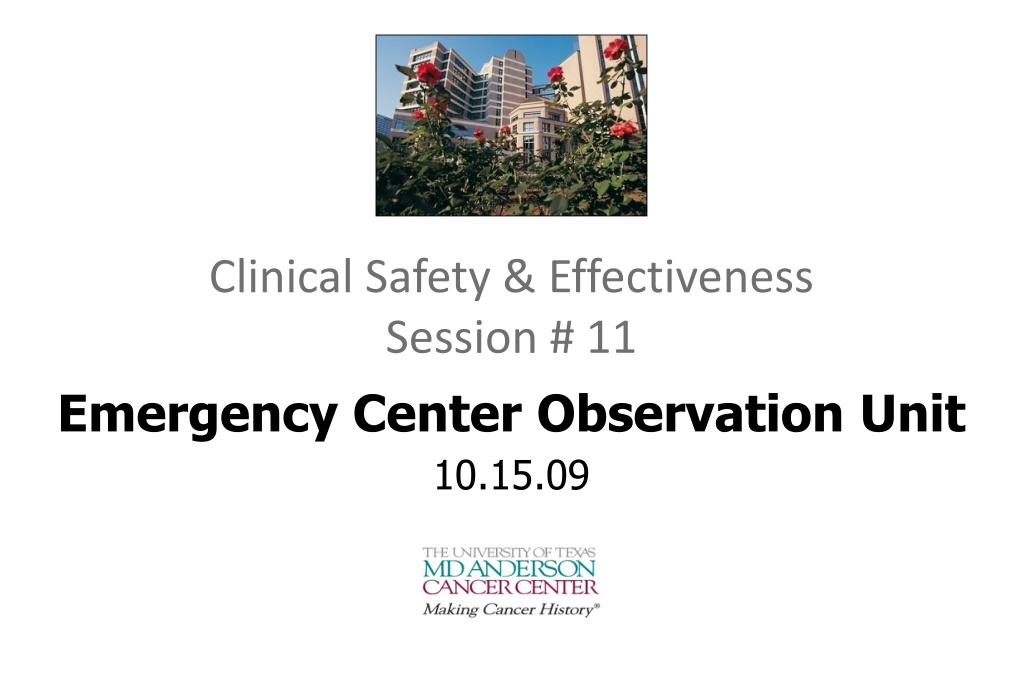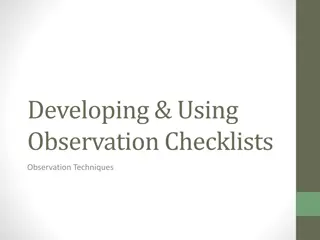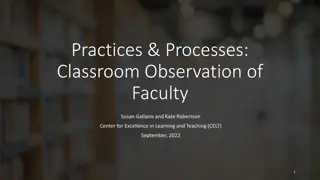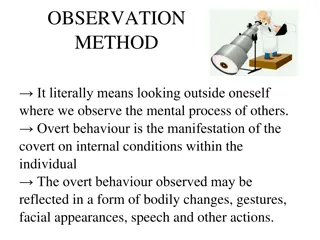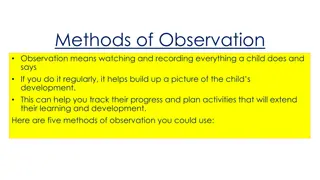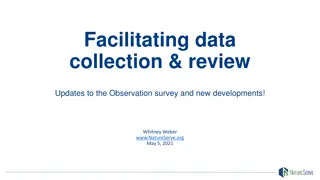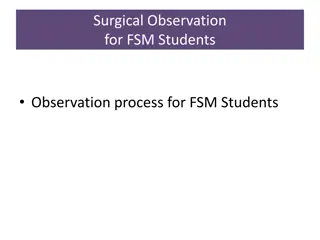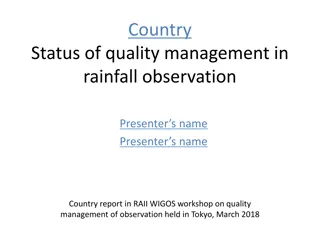Improving Patient Care and Safety in the Emergency Center Observation Unit
The project aims to enhance patient care and safety in the Emergency Center by reducing the length of stay, which currently averages 9.5 hours, affecting patient care and safety. The team led by Dr. Patrick Chafitari and Dr. Jean Tayar explores solutions to optimize patient outcomes, satisfaction, and bed utilization. By implementing strategies such as the Observation Unit, the initiative aims to improve quality of care, revenue, patient outcomes, and reduce liabilities, frustrations, and costs. This comprehensive approach targets efficient use of resources and decreased unnecessary admissions, ultimately aiming to enhance overall emergency center operations.
Download Presentation

Please find below an Image/Link to download the presentation.
The content on the website is provided AS IS for your information and personal use only. It may not be sold, licensed, or shared on other websites without obtaining consent from the author. Download presentation by click this link. If you encounter any issues during the download, it is possible that the publisher has removed the file from their server.
E N D
Presentation Transcript
Clinical Safety & Effectiveness Session # 11 Emergency Center Observation Unit 10.15.09 DATE
Project Team Patrick Chaftari, MD Assistant Professor , GIM, AT & EC Jean H Tayar, MD Assistant Professor, GIM, AT & EC Ashutosh Gupta Clinical Business Manager, EC Richard A. Ivey Quality Engineer, Office of Performance Improvement Cindy Segal Clinical Quality Improvement Consultant, Office of Performance Improvement Cylette R. Willis, PhD Associate Director, Quality Education and Evaluation, Office of Performance Improvement Project Sponsor: Carmen E. Gonzalez, MD Associate Professor, GIM, AT and EC Section Chief, EC
EC Situation National benchmark ER Length of Stay (LOS) is 4 hours MDACC EC LOS averages 9.5 hours (up to 24 hrs ) Current situation affects patient care and safety
Can We Improve This Picture? Patient safety Patient care Patient satisfaction Bed utilization
Pts Treated while in The EC (No Inpt Admission) Patients Treated While in EC (No Admission) 20+ Hrs, N= 675 6% 16-20 Hrs, N=642 6% 11-15 Hrs, N=1,328 12% 00-05 Hrs, N=4,734 42% 06-10 Hrs, N=3,879 34% % of Visits by Hours in EC from Lobby Sign-In to Leave Time April 1, 2008 to March 31, 2009 1 year Data Prepared by: Linda DeFord OPI Clinical Informatics Data Source: EC Tracking Data
Snapshot of Patients Discharged from EC After a LOS > 16 hrs (14) 12% (27) 23% (74) 62% 16-20 Hrs N=642 (March 2009, 119 pts) 6% 20+ Hrs N= 675 6% One year data
OBS Unit Better Care Opportunity to improve patient safety and patient care Literature review: Placement on OBS will improve quality of care and revenue Improve disposition clinical outcome decrease liability Decrease patient and caregiver frustrations Free up EC bed Decrease some of the EC congestion Shortens LOS Decrease cost by efficient usage of EC and inpatient bed Avoid unnecessary admissions and decrease un-reimbursed readmissions
Observation Unit Observation unit could be a safe effective cost-saving way of ensuring that patients who are considered to be intermediate category receives appropriate care. 10
AIM Statement The aim of this project is to increase the percentage of EC patients placed on Observation by 50% from the baseline of 1.95% to 2.93% during the pilot period, July 1 - July 22, 2009. Baseline period: May 2008 - April 2009 Process begins when provider evaluates patient in EC and ends when provider places patient on Observation Value to the organization improve patient care and safety, potential financial advantage
How Will We Know That a Change is an Improvement? Outcome measure: Percentage of EC patients placed on Observation Data collection: Whiteboard activity report Technical charges Specific target: 2.93%
Project Milestones Team created April 2009 AIM statement created April 2009 Weekly team meetings May - August Planning April - June Interventions implemented July 1 22 Presentation August 7
Fishbone Diagram Physicians Nurses Clerks Don t think about it Training Training Staffing Lack of education Paperwork Data entry Do not understand billing Do not check observation box on charge sheet Guidelines for disposition decision Confirm access to CARE system Do not notify clerks that patient placed on Observation Lack criteria to place on Observation LOW NUMBER OF PATIENTS PLACED ON OBSERVATION Unclear processes Whiteboard does not visually identify current Observation patients Lack of space Order sets Identifying Observation patients Budget to staff Tracking LOS countdown Tracking patient progression space Physician hand-off Appropriate forms Technology Facilities Processes
PLAN: The Intervention Plan project Develop presentation materials for providers Design new EC physician order set and forms Start general guidelines for placing patients on Observation Gain leadership buy-in Raise awareness of OBS availability
Observation Placement Form Placeholder for Obs form and/or physician order set visual
DO: Implement the Changes April June: July 1: July 1 22: Build awareness (soft implementation) Implement interventions Measure outcomes July 1 July 2 July 3 July 4 July 5 July 6 July 7 July 8 Conduct kickoff in EC Implement order sets Post order sets online Place poster
EC Observation start date: July 1st,09 Upon completion of the patient s work-up Consider Observation placement And you expect improvement within the next 23h to the point where the patient could be discharged home Patient is not ready to be discharged home Patient do not meet admission criteria
Implementation Issues Stakeholder identification was incomplete (Clinical Effectiveness) Delay in posting physician order set Implementation period was too short to address EC meeting schedule, introduce language and new forms Non-EC faculty working in the EC not familiar with the process
Results 21
CHECK: Results and Impact Baseline (May 1, 2008 April 30, 2009) Project Intervention Period (July 2009) 1.95 % 5.20 % OBS Patients 391 87 Total Number of patients 20086 1674 Test of proportions p-value < 0.001
Percent of Patients Placed on Observation of the Total EC Visits (Monthly) May-08 Apr-09 9.0% UCL=8.3% Percent of Patients Placed on Obs (%) 8.0% 7.0% 6.0% _ X=4.6% 5.0% 4.0% 3.0% 2.0% 1.0% LCL=0.8% 0.0% May-08 Jun-08 Jul-08 Aug-08 Sep-08 Oct-08 Nov-08 Dec-08 Jan-09 Feb-09 Mar-09 Apr-09 May-09 Jun-09 Jul-09 Month Before/After Intervention Test of Means, p-value = 0.004 Source: EC Whiteboard Prepared By: Ash Gupta & Richard Ivey
Percent of Patients Placed on Observation of the Total EC Visits (Daily) 9-Jun 9-Jun 1-Jul 1-Jul 0.18 0.16 Percent of Patient Placed on Obs UCL=0.1435 0.14 0.12 1 1 0.10 0.08 _ P=0.0534 0.06 0.04 0.02 0.00 LB=0 3-Jul 6-Jul 9-Jul 12-Jul 15-Jul 18-Jul 21-Jul 9-Jun 12-Jun 15-Jun 18-Jun 21-Jun 24-Jun 27-Jun 30-Jun Day Before/After Intervention Test of Means, p-value = 0.002 Tests performed with unequal sample sizes Source: EC Whiteboard Prepared By: Ash Gupta & Richard Ivey
Potential Financial Impact What is the financial impact of these results on the organization? Decrease waste by more efficient use of EC bed and inpatients beds Capture of uncharged technical and professional fees Bed utilization and resources
Annual Technical Charges for Patients with EC Stay > 16 Hours and Discharged Home $2,000,000 $1,800,000 Expected Charges Including Obs $1,600,000 Estimated Actual Charges Estimated Annual Technical Charge $1,400,000 Assuming 62% of patients with EC stay > 16 hours and discharged home were placed on obs, this represents a potential benefit of approximately $650,000 $1,200,000 $650,000 $1,000,000 $800,000 Data source: EC Whiteboard to compute LOS (May '08 - Apr '09) $600,000 Note: To estimate the actual technical charges for patient with EC stay > 16 hours, an average approach was used using Levels 4 and 5 charge amounts $400,000 $200,000 $0 0% 10% 20% 30% 40% 50% 60% 70% 80% 90% 100% Percent of Patients Placed on Obs with EC Stay > 16 Hours Source: EC Whiteboard Prepared By: Ash Gupta & Richard Ivey
Estimated Annual Professional Charges for Patients with EC Stay > 16 Hours and Discharged Home $1,600,000 Standard Recovery Obs - 1 provider Obs - 2 providers $1,400,000 Assuming 62% of patients with EC stay > 16 hours and discharged home were placed on obs, this represents a potential benefit of approximately $428,000 $1,200,000 Estimated Annual Professional Charge $1,000,000 $428,000 Data source: EC Whiteboard (May '08 - Apr '09) $800,000 To estimate the charges for patients with EC stay > 16 hours, an average approach was used using Levels 4 and 5 charge amounts $600,000 Obs 1 provider assumes that the EC provider is caring for the obs patient $400,000 Obs 2 providers assumes that a non-EC provider is caring for the obs patient $200,000 $0 10% 20% 30% 40% 50% 60% 70% 80% 90% 100% Percent of Patients Placed on Obs with EC Stay > 16 Hours Source: EC Whiteboard Prepared By: Ash Gupta & Richard Ivey
Annual Cost Requirement for Unit Annual Cost Physician provider (1) $250,000 Nurse (4.2 FTE) $267,260 Medical supplies (4% of Annual EC Medical Supplies) TOTAL Cost $ 17,129 $543,389 FTE is based on the assumption that the Observation unit will be operational 24/7 Personnel Cost is based on new staff with less than 1 year at M.D. Anderson Medical supplies/expense = 4% of Total EC Medical supplies Deduction % = 48.67
Avg Utilization Rate vs Number of Observation Beds in Operation 100% 90% 80% Utilization of Obs Beds 70% 60% The 'Utilization of Obs Beds' is calculated as the average amount of time occupied divided by the total time available (24-7). This is done by looking at each of the dedicated beds over the entire year. Utilization Rate 50% 40% 30% The choice of number of obs beds should be balanced with the number of patients waiting for a bed 20% 10% 0% 3 4 5 6 Number of Dedicated Observation Beds 7 8 9 10 11 12 Source: EC Whiteboard Prepared By: Richard Ivey
ACT: Expansion of Implementation Maintain and expand awareness of available OBS services in the EC Improve identification of OBS patients in the EC Review appropriate use of OBS placement Track progress of revenue realization
Conclusions OBS unit could be a viable solution to improve patient safety and quality of care in the EC By decreasing waste and capturing uncharged services OBS unit may provide net revenue to organization
Recommendations Designated OBS Unit (Closed unit) Access limited to EC provider and/or observation provider Virtual or Shared OBS unit within Pod A Designated non-EC provider coverage Improve safety and quality of patient care Cost of additional provider offset by fee structure
What have we accomplished so far? Increased number of observation patients to 5.57% Improved patient safety Medication reconciliation Diet, activity, fluid infusion Improved quality of care Better oversight by having an APN following these patients on OBS Increased RN satisfaction and confidence Improving communication about plan of care 42
Percent of Patients Placed on Observation of the Total EC Visits (Monthly) May-08 Apr-09 Percent of Patients placed on Observation 8.0% UCL=7.8% 7.0% 6.0% _ X=4.8% 5.0% 4.0% 3.0% 2.0% LCL=1.7% 1.0% 0.0% May-08 Jun-08 Jul-08 Aug-08 Sep-08 Oct-08 Nov-08 Dec-08 Jan-09 Month Feb-09 Mar-09 Apr-09 May-09 Jun-09 Jul-09 Aug-09 Before/After Intevention Test of Means, p-value < 0.001 Source: EC Whiteboard Prepared By: Ash Gupta & Richard Ivey 43
Questions Thank you
